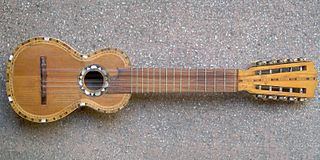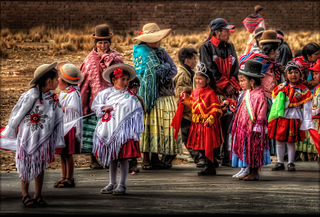Related Research Articles

Bolivia, officially the Plurinational State of Bolivia, is a landlocked country located in central South America. It is a country with the largest geographic extension of Amazonian plains and lowlands, mountains and Chaco with a tropical climate, valleys with a warm climate, as well as being part of the Andes of South America and its high plateau areas with cold climates, hills and snow-capped mountains, with a wide biome in each city and region. It is part of the largest swamp in the world between Bolivia and Brazil. It is bordered by Brazil to the north and east, Paraguay to the southeast, Argentina to the south, Chile to the southwest, and Peru to the west. The seat of government is La Paz, which contains the executive, legislative, and electoral branches of government, while the constitutional capital is Sucre, the seat of the judiciary. The largest city and principal industrial center is Santa Cruz de la Sierra, located on the Llanos Orientales, a mostly flat region in the east of the country with a diverse non-Andean culture.

South America is a continent entirely in the Western Hemisphere and mostly in the Southern Hemisphere, with a considerably smaller portion in the Northern Hemisphere. It can also be described as the southern subregion of the Americas.
The music of Latin America refers to music originating from Latin America, namely the Spanish and Portuguese-speaking regions of the Americas south of the United States. Latin American music also incorporate the indigenous music of Latin America. Due to its highly syncretic nature, Latin American music encompasses a wide variety of styles, including influential genres such as cumbia, bachata, bossa nova, merengue, rumba, salsa, samba, son, and tango. During the 20th century, many styles were influenced by the music of the United States giving rise to genres such as Latin pop, rock, jazz, hip hop, and reggaeton.
Telecommunications in Bolivia includes radio, television, fixed and mobile telephones, and the Internet.
Transport in Bolivia is mostly by road. The railways were historically important in Bolivia, but now play a relatively small part in the country's transport system. Because of the country's geography, aviation is also important.

The charango is a small Andean stringed instrument of the lute family, from the Quechua and Aymara populations in the territory of the Altiplano in post-Colonial times, after European stringed instruments were introduced by the Spanish during colonialization. The instrument is widespread throughout the Andean regions of Bolivia, Peru, Ecuador, northern Chile and northwestern Argentina, where it is a popular musical instrument that exists in many variant forms.
A roots revival is a trend which includes young performers popularizing the traditional musical styles of their ancestors. Often, roots revivals include an addition of newly composed songs with socially and politically aware lyrics, as well as a general modernization of the folk sound.

Andean music is a group of styles of music from the Andes region in South America.
The music of Bolivia has a long history. Out of all the Andean countries, Bolivia remains perhaps the most culturally linked to the indigenous peoples.

Bolivia is a country in South America, bordered by Brazil to the north and east, Paraguay and Argentina to the south, Chile to the west, and Peru to the west.

Los Kjarkas is a Bolivian band from the Capinota province in the department of Cochabamba, and one of the most popular Andean folk music bands in the country's history. Among the styles they play are Saya, tuntuna, huayno, and carnavales. The instruments they use include the charango, quena, zampoña, ronroco, guitar, and bombo.

Cueca is a family of musical styles and associated dances from Chile, Argentina, and Bolivia. In Chile, the cueca holds the status of national dance, where it was officially declared as such by the Pinochet dictatorship on September 18, 1979.

Quechua people, Quichua people or kichwa people may refer to any of the indigenous peoples of South America who speak the Quechua languages, which originated among the Indigenous people of Peru. Although most Quechua speakers are native to Peru, there are some significant populations in Ecuador, Bolivia, Chile, Colombia, and Argentina.

The Kallawaya are an indigenous group living in the Andes of Bolivia. They live in the Bautista Saavedra Province and Muñecas Province of the La Paz Department but are best known for being an itinerant group of traditional healers that travel on foot to reach their patients. According to the UNESCO Safeguarding Project, the Kallawaya can be traced to the pre-Inca period as direct descendants of the Tiwanaku and Mollo cultures, meaning their existence has lasted approximately 1,000 years. They are known to have performed complex procedures like brain surgery alongside their continuous use of medicinal plants as early as 700 AD. Most famously, they are known to have helped to save thousands of lives during the construction of the Panama Canal, in which they used traditional plant remedies to treat the malaria epidemic. Some historical sources even cite the Kallawayas as the first to use quinine to prevent and control malaria. In 2012, there were 11,662 Kallawaya throughout Bolivia.

Afro-Bolivians are Bolivian people of Sub-Saharan African heritage and therefore the descriptive "Afro-Bolivian" may refer to historical or cultural elements in Bolivia thought to emanate from their community. It can also refer to the combining of African and other cultural elements found in Bolivian society such as religion, music, language, the arts, and class culture. The Afro-Bolivians are recognized as one of the constituent ethnic groups of Bolivia by the country's government, and are ceremonially led by a king who traces his descent back to a line of monarchs that reigned in Africa during the medieval period. They numbered 23,000 according to the 2012 census.

Televisión Boliviana is the first television channel of Bolivia and serves the only means of television communication from the government. The channel was established in August 1969 under the government of Luis Adolfo Siles after years of planning by the government of then-recently deceased René Barrientos. It is a state-owned broadcasting network.
Javier Parrado is a Bolivian classical composer, whose works have been performed in Europe, and Latin America.

The Rough Guide to the Music of the Andes is a world music compilation album originally released in 1996. Part of the World Music Network Rough Guides series, the album features the music of the Andes Mountains of South America, focusing especially on the music of Bolivia, whose musicians contributed eleven tracks. Also featured are Peru and Chile. The compilation was produced by Phil Stanton, co-founder of the World Music Network.

The architecture of Bolivia is closely related to its history, culture and religion. Bolivian architecture has been constantly changing and progressing over time. Subject to terrain and high altitudes, most of Bolivia's Pre-Columbian buildings were built for housing, mainly influenced by Bolivian indigenous culture. The arrival of Spanish settlers brought many European-style buildings, and the Spaniards began planning to build big cities. After Independence, the architectural style became Neoclassical and many churches and government buildings were built. In modern Bolivia, like many countries, skyscrapers and post-modern buildings dominate, and of course there are special styles of architecture to attract tourists and build.
Events in the year 2021 in Bolivia.